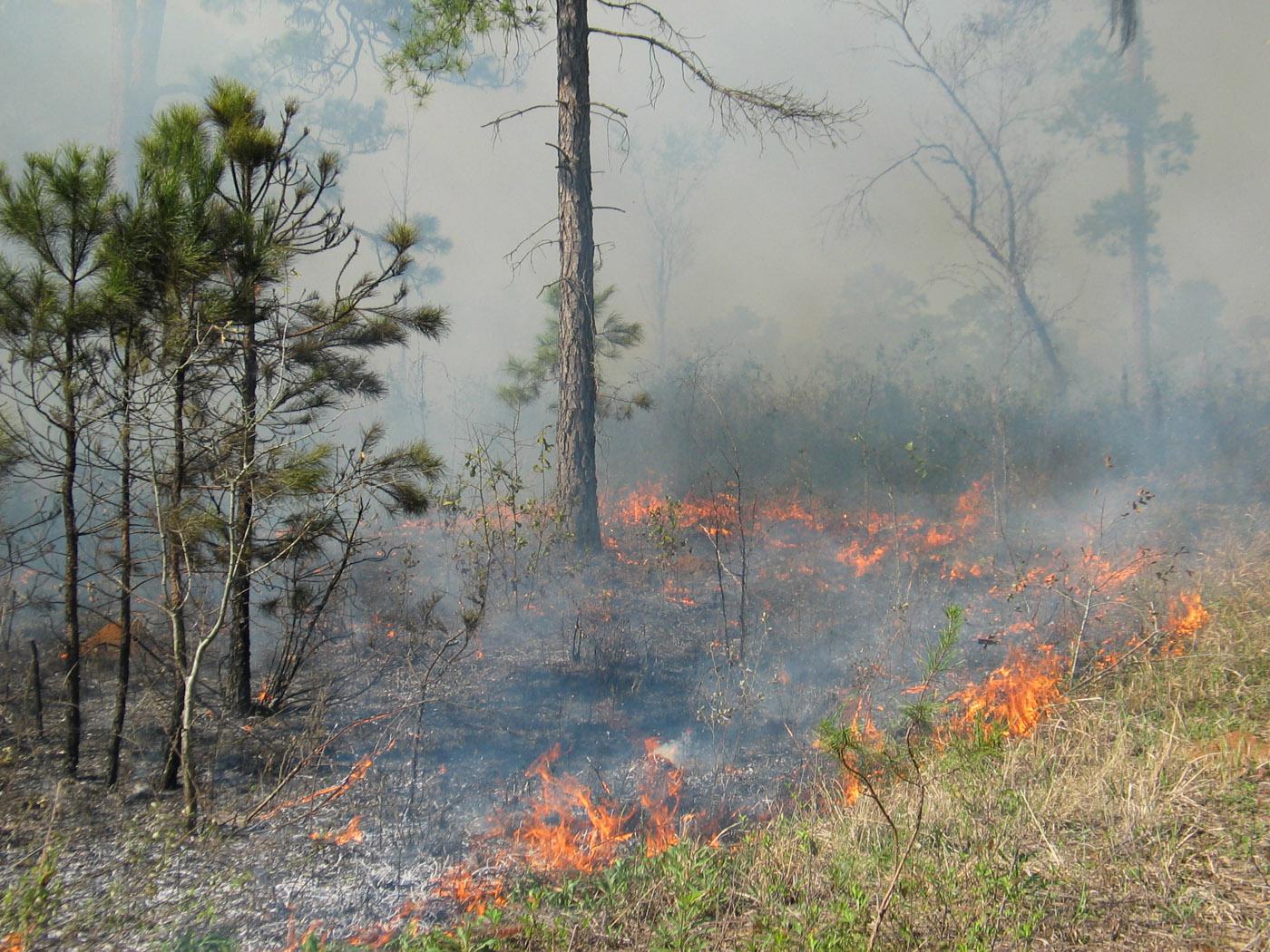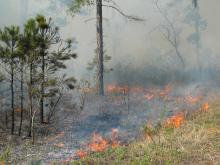Information Possibly Outdated
The information presented on this page was originally released on May 20, 2010. It may not be outdated, but please search our site for more current information. If you plan to quote or reference this information in a publication, please check with the Extension specialist or author before proceeding.
Controlled fire is good for wildlife, forestry
MISSISSIPPI STATE – Natural and manmade fires are important forest management tools, and problems can develop when fire is eliminated.
“Native Americans used fire as a natural and essential process to burn underbrush and promote growth of understory vegetation in timberlands,” said Wes Burger, a professor in Mississippi State University’s Department of Wildlife, Fisheries and Aquaculture. “Fire is an important ecological process in Southern pine forests, responsible for the creation and maintenance of pine savannas that once dominated the uplands of the Southeastern Coastal Plain.”
However, managed use of prescribed fire has declined throughout the region. This has resulted in many of today’s Southeastern pine forests being a tangled mess of thick, low-quality hardwood brush and shade-tolerant trees that flourish beneath the pine canopy. Wildlife habitat is scarce in these areas, Burger said.
“Without fire, hardwood brush and shrubs come to dominate the midstory, shading out the diverse native grass, forb and legumes groundcover on which many wildlife species depend,” Burger said.
When fire is withheld for several decades, a pine grassland forest will be replaced by a mixed pine/hardwood stand and eventually a hardwood-dominated forest, Burger added.
The absence of fire and subsequent loss of open pine grassland habitats has created a decline in many wildlife species, including the northern bobwhite quail, red-cockaded woodpecker, Bachman’s sparrow, brown-headed nuthatch, gopher tortoise and indigo snake.
“Fire exclusion from these fire-dependent systems has perhaps had greater impact than any other factor on the function and integrity of Southeastern forest ecosystems,” Burger said.
Ground-nesting birds and other wildlife that depend on these habitats are not the only ones to lose with the decline in prescribed fires. Pine forests deteriorate without this management tool.
“The absence of prescribed fire increases the chances of wildfires,” said Edwin Sun, associate forestry professor.
Fire suppression allows fuel such as dead limbs, grass and needles to accumulate over time, leading to increased risk of dangerous wildfires, Sun said. Prescribed fire is the best prevention for wildfires.
Fire provides numerous benefits to Southern forest ecosystems. It improves accessibility by controlling unwanted vegetation and helps control and prevent diseases.
“Yet even with these advantages, the use of prescribed burning has become more challenging in recent years. To a large degree, this is due to the increasing concerns of landowners over liability exposure and legal consequences from smoke and escaped fires,” Sun said.
A study in MSU’s Forest and Wildlife Research Center examined the legal environment of prescribed burning and the 1992 Mississippi Prescribed Burning Act.
“The Mississippi Prescribed Burning Act specifically recognizes the right of landowners to use prescribed fire as a management tool to accomplish ecological, forestry, wildlife management and fuel reduction goals,” Sun said.
Mississippi is not the only state to pass such a law. Led by Florida in 1990, prescribed fire laws explicitly limit the liability of those who use prescribed fire in a safe, legal and responsible fashion, Sun said.
Ten Southern states have passed laws to define prescribed fire as a legal activity with ecological and social benefits that does not constitute a public or private nuisance. The laws provide a measure of limited liability protection for damages and injuries resulting from fire or smoke, given that negligence is not proven.
“There have been increasing administrative regulations on the use of prescribed burning in Mississippi with the passage of the Prescribed Burning Act,” Sun said. “However, these regulations are designed to provide liability protection and preserve the right to use fire as a management tool.”
Prescribed burn laws vary from state to state in specific requirements, but in general, three or four conditions for liability protection have been established. Mississippi requires a burning permit, a written fire prescription or burn plan, and the use of a trained, certified prescribed burner.
The required burn permit may be obtained from the Mississippi Forestry Commission only when conditions to burn are favorable. The written fire prescription or burn plan specifies the conditions or parameters for the burn. Details include a description and map of the site to be burned, purpose of the burn, range of desired weather and summary of the burn.
“It is important that the burn be conducted within the parameters specified in the plan,” Sun said. “Execution of the burn outside of the parameters specified in the burn plan could constitute negligence and subject the burner to increased liability.”
A certified prescribed burn manager is one who has training and the required experience in fire behavior and planning and implementing prescribed burns. To find a certified burn manager, contact the local Mississippi Forestry Commission office.
Some states require notification of neighbors, local fire departments and municipalities before executing a prescribed burn. Such notification is not required in Mississippi, but it is not a bad idea to avoid unnecessary emergency responses, Sun added.
The legislature has provided these regulations so that landowners can use fire as a management tool without fear of litigation. The state has also joined other states in developing a fire council.
The Mississippi Prescribed Fire Council was developed to increase occurrence of burning on public and private lands to restore ecological function, enhance wildlife and plant communities, and reduce hazardous forest or grassland fuel loads.
“The council and wildlife biologists are promoting the use of prescribed fire, in combination with heavy timber thinning and midstory competition control, to create and maintain Southern pine forests that are aesthetically pleasing and provide essential habitat for wildlife species of conservation concern,” Burger said.
The key is to get private, nonindustrial landowners, who hold about 135 million acres in the Southeast, to actively manage their land with prescribed fire.
“Landowners can create habitat for game species such as quail and turkey and numerous nongame species, including gopher tortoise, Bachman’s sparrow and brown-headed nuthatches, by adding prescribed fire to their management plans,” Burger said.








